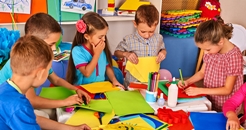 Can kindness be taught?
Can kindness be taught?
The Random Acts of Kindness Foundation in the USA have developed free lesson plans for children from 4-16 to help teach kindness. Students are guided in classroom discussions and asked to come up with positive actions, like sitting with someone who is alone in the lunchroom and writing imaginative thank you letters to their future selves.
They have found, based on independent studies, that teaching kindness really does make a difference.
Students behave better, discipline rates have decreased, they are more inclusive of others, student conflicts have decreased and the relationships between students and teachers is much stronger.
In one study, after one year of implementation, teachers rated their classroom climate as significantly more positive, especially related to students’ involvement in community service, respect for one another, and feelings of classroom cohesion. In addition, teachers rated their school climate as significantly more positive, especially related to the school’s willingness to help one another and the community, and adults’ reinforcing and modeling of kindness with colleagues and students.
Teachers rated students’ social-emotional skills significantly higher, with the typical student’s total skill score increasing from the 44th percentile to the 66th percentile. Male students showed particular improvement in the areas of decision making skills and self-awareness; female students showed particular improvement in the areas of optimistic thinking and social awareness.
Teachers rated students’ academic competence as generally improved (from the 55th percentile to the 59th percentile). Male students showed a statistically significant improvement, with academic competence ratings increasing from the 55th percentile to the 61st percentile.
In another initiative in the USA, a 12-week Kindness Curriculum developed by the Center for Healthy Minds at the University of Wisconsin–Madison was trialled with 6 schools. Twice a week for 20 minutes, pre-kindergarten kids were introduced to stories and practices for paying attention, regulating their emotions and cultivating kindness.
Sixty-eight students participated in the research, with about half going through the Kindness Curriculum and the other half measured as a comparison. To investigate the impact of the curriculum, they tested children before and after the training period. The results of the study were promising. Students who went through the curriculum showed more empathy and kindness and a greater ability to calm themselves down when they felt upset, according to teachers’ ratings. In an exercise with stickers, they consistently shared about half of them, whereas students who hadn’t gone through the curriculum shared less over time. They earned higher grades at the end of the year in certain areas (notably for social and emotional development), and they showed improvement in the ability to think flexibly and delay gratification, skills that have been linked to health and success later in life.
What does such a Kindness Curriculum consist of? The one at the Center for Healthy Minds was designed around A to G:
-
Attention. Students learn that what they focus on is a choice. Through focusing attention on a variety of external sensations (the sound of a bell, the look of a stone) and internal sensations (feeling happy or sad), children learn they can direct their attention and maintain focus.
-
Breath and Body. Students learn to use their breath to cultivate some peace and quiet. Using breathing to calm the body.
-
Caring. Think about how others are feeling and cultivate kindness. Stories and brainstorming ways to help – as simple as offering a smile.
-
Depending on other people. We emphasize that everyone supports and is supported by others. Students learn to see themselves as helpers and begin to develop gratitude for the kindness of others.
-
Emotions. What do emotions feel like and look like? How can you tell what you’re feeling? Gameplay pretending to be angry, sad, happy or surprised, guessing which emotion was expressed, and talking about what that emotion feels like in the body.
-
Forgiveness. Young children can be particularly hard on themselves – and others – everyone makes mistakes. A story of someone who has made a mistake but is forgiven.
-
Gratitude. Recognise the kind acts that other people do for them, like bus drivers. Then, talk about being thankful to those people for how they help us.
Schools have mainly focused on intellectual learning but by teaching the cooperative emotional skills as well as early as possible, they may get students to flourish.
Then there is always children's work at church. Why not have a kindness season to teach some of the above?
See also Random App of Kindness article.
Retweet about this article:
Geoff Knott, 17/01/2018